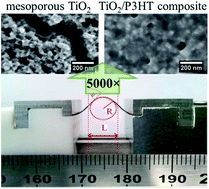Aging of low-temperature derived highly flexible nanostructured TiO2/P3HT hybrid films during bending†
Abstract
To meet the demand for low-cost, lightweight, portable and building-integrated solar cells, developing flexible and cost-efficient photo-active hybrid films is of significant interest. In this work, we investigate the mechanical properties of hybrid layers consisting of mesoporous TiO2 filled with poly(3-hexylthiophene-2,5-diyl) (P3HT) as a function of the number of bending cycles. The TiO2/P3HT layers are deposited on flexible PET substrates at low temperatures (≤140 °C), which is beneficial for reducing the processing energy input and in turn lowering the production costs. Non-filled and partially filled mesoporous titania films are studied for comparison. The surface morphology is examined with scanning electron microscopy (SEM) before and after the bending tests. The inner film morphology is characterized with grazing incidence small-angle X-ray scattering (GISAXS). Based on the observed morphology, micromechanical models are used to analyze the mechanical properties of the investigated films. The results show that the TiO2/P3HT layers have a low elastic modulus and P3HT helps to stabilize the titania nanostructures against fracture. The SEM observations are well explained with the established models in a quantitative way.



 Please wait while we load your content...
Please wait while we load your content...